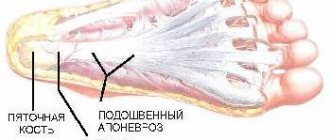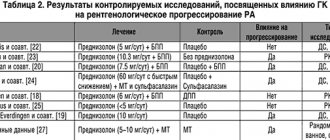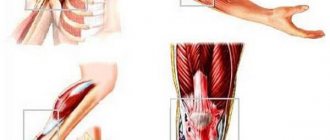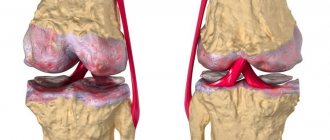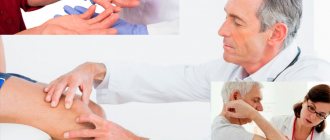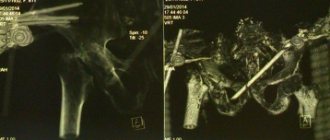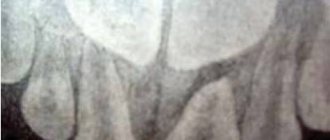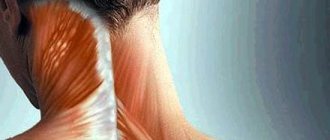Causes of Arthritis
Arthritis is a consequence of damage to the articular cartilage or the entry of microorganisms into the synovial fluid.
In the first case, the pathology occurs due to degenerative processes in tissues due to injury or osteoarthritis. The causes of inflammatory arthritis are infection and waste products of microorganisms when:
- migration of the pathogen through blood and lymphatic vessels from nearby tissues;
- infectious diseases affecting the entire body - tuberculosis or gonorrhea;
- toxic-allergic effects of by-products of microorganisms;
- an allergic reaction to the body’s own tissues after an infection or in the presence of a permanent focus of inflammation, accompanied by a disruption in the functioning of the immune system;
- injury to the joint and infection through the wound or aseptic inflammation.
The following factors contribute to the occurrence of the disease:
- hereditary predisposition;
- increased load on the musculoskeletal system;
- infectious diseases;
- consuming large amounts of caffeine;
- smoking;
- excess weight;
- allergic reaction;
- metabolic disorders;
- traumatic injury;
- hypovitaminosis and lack of nutrients;
- pathology of the nervous system;
- malfunctions of the immune system;
- improper diet, consumption of alcoholic beverages;
- hormonal disorders;
- stinging insect bites;
- hypothermia of the body.
Causes of uncovertebral arthrosis
Destruction of cartilage and adjacent bone tissue can occur for congenital and acquired reasons. The development of dystrophic-degenerative processes is triggered by:
- developmental anomalies (for example, Oljenik's syndrome - fusion of the 1st cervical vertebra with the occipital bone, congenital underdevelopment of the cervical spine);
- foot abnormalities (for example, flat feet) and injuries to the lower extremities (dislocation of the hip joint and others);
- postural disorders and other factors causing deviation of the axial load on the spinal column;
- professional and sports activities associated with debilitating load on the cervical spine;
- sedentary lifestyle and excess weight (especially excess fat deposits in the neck, shoulders, arms);
- cervical spine injuries;
- metabolic and endocrine disorders, incl. associated with chronic illness or stress;
- previous polio and other severe diseases of the nervous system;
- dystrophy of paravertebral and other adjacent muscles.
Insufficient load on the cervical spine is no less dangerous than excessive load.
Classification
Arthritis, depending on the cause and clinical form, is of the following types:
- rheumatoid arthritis associated with malfunctions of the immune system;
- rheumatic, with chronic connective tissue disease with predominant damage to the heart and joints;
- ankylosing spondylitis, or ankylosing spondylitis - inflammation of the joints of the spine;
- infectious, with direct penetration of infectious agents into the joint;
- reactive arthritis - an immune response to a previous infectious disease;
- psoriatic arthritis is a chronic immune-mediated inflammatory disease of the osteoarticular system that develops in patients with psoriasis;
- gouty – occurs due to the deposition of uric acid in the joints;
- inflammation in systemic connective tissue diseases, for example, systemic lupus erythematosus;
- arthritis due to diseases of the gastrointestinal tract, lungs and other organs and systems;
- traumatic, occurring after an injury;
- juvenile idiopathic arthritis in children under sixteen years of age.
Based on the number of joints affected, monoarthritis is distinguished with inflammation of only one, oligoarthritis, if two or three areas are affected, and polyarthritis - a disease of more than three joints.
The process can be acute or chronic. In the first case, it develops rapidly, accompanied by severe pain and inflammation in the tissues. Chronic disease progresses gradually, slowly turning into a serious disease.
How does the disease manifest itself?
The disease can begin with acute pain in any part of the back, which intensifies with active movements and bending. But more often it all starts with a “tolerable” feeling of discomfort in the interscapular, lumbar, and shoulder girdle areas. Discomfort intensifies in the evening, with weakness of the paravertebral muscles, or in the morning, as a result of poor sleep conditions.
The spinal column bears a colossal mechanical load, but at the same time it is a complex anatomical formation in which circulatory, supporting, and spinal structures innervating the entire human body are closely intertwined. That is why changes in the spine, which lead to compression or irritation of the spinal elements, can manifest as pathology of any internal organs (headache, vascular dystonia, hypertension, arrhythmia, sexual dysfunction, etc.). The ancients argued: “if there are many diseases and they cannot be cured traditionally, then there is only one disease and the spine needs to be treated.”
Arthritis symptoms
Manifestations of the disease depend on its clinical form and severity of the process. The main symptoms of arthritis include local manifestations of inflammation in the joint - pain, redness and swelling of surrounding tissues, limited mobility, deformation as pathological changes progress. There is also a local increase in temperature, the affected area becomes hot when touched.
Infectious
The course of the disease depends on the type of pathogen. Often there is a sharp increase in temperature, chills, headache, and weakness. Tuberculous arthritis occurs in a chronic form, is difficult to treat and leads to severe dysfunction of the affected joint. With gonorrhea, as a rule, acute serous inflammation develops. Viral lesions go away after the infection is cured.
Gouty
Gout is a metabolic disorder that is accompanied by the deposition of uric acid salts - urates - in the joints. They penetrate the tissues, forming gouty nodes or tophas. The metatarsophalangeal joints of the thumbs are usually affected first, followed by arthritis in other areas. During an exacerbation of the disease, acute inflammation develops with tissue swelling and severe pain. After several attacks of gout, the joint becomes deformed and its function is impaired.
Rheumatoid
An autoimmune reaction develops with damage to the body’s own tissues, including joints. The causes of the disease have not been precisely established, but it is known that inflammation is triggered by infection in the body. At the onset of the disease, there is an increase in body temperature, the patient is worried about morning stiffness - a gradually passing limitation of mobility after waking up, pain and swelling at the site of inflammation. Symptoms may spontaneously disappear for several months, followed by exacerbation and progression of the disease. Damage to the hand and fingers is typical, but there are cases of atypical reactive arthritis with inflammation of the knee or shoulder joint. Gradually, without treatment, articular cartilage is destroyed, connective tissue grows, subluxations and dislocations occur, leading to disability of the patient.
Traumatic
Develops after injury to large joints - hip, knee, shoulder and others. There is pain, swelling and crunching when moving. With a closed injury and aseptic inflammation, spontaneous recovery is possible. With an open wound, the infection penetrates deep into the tissue and can cause purulent inflammation.
Psoriatic
It is characterized by damage to the terminal interphalangeal joints of the fingers and nails with simultaneous asymmetric damage to several other areas. The course of the disease occurs with relapses and remissions.
Reactive
This form is associated with a toxic-allergic reaction to an infection that develops within a week after a bacterial, viral or fungal infection. It occurs acutely, affecting 1-3 large joints. Characterized by pain at the site of inflammation, redness, swelling of surrounding tissues, and limited mobility. Other symptoms of inflammatory damage to the eye mucosa and urinary tract may also be present.
Juvenile idiopathic
Arthritis of unknown cause in children under sixteen years of age. It is believed that the basis is the genetic predisposition of the child. Prolonged exacerbations alternate with remissions and lead to early disability of the patient.
1.What is osteoarthritis and its symptoms?
Did you know that there are more than 100 types of arthritis? Common symptoms of this disease are pain, stiffness and impaired joint mobility. The most common type of arthritis is degenerative arthritis
, or
osteoarthritis
, which we will talk about in this article. Less common are rheumatoid arthritis and gout. Accurately diagnosing the type of arthritis is very important to selecting the right treatment.
What is osteoarthritis?
In general, the term “arthritis”
indicate
inflammation of the joints
. Osteoarthritis is its most common form. The disease is associated with damage to joint cartilage and can occur in any joint in the body. The joints that bear the heaviest weight loads are most often affected - the joints of the hips, knees and spine. The joints of the fingers, especially the thumb, and neck are often affected.
cartilage
- This is an elastic material that is found at the ends of the joints of the bone. The main function of cartilage is to reduce friction in the joints, that is, to serve as a kind of shock absorber. This opportunity is provided by the ability of healthy cartilage to change shape under compression and pressure (cartilage can become flat and press against each other).
Osteoarthritis leads to joint stiffness and loss of elasticity
. Over time, cartilage can wear out in some areas, become damaged, and as a result, the shock-absorbing ability of the cartilage is significantly reduced. As a result, tendons and ligaments are stretched and bones rub against each other, causing pain.
Osteoarthritis is a fairly common problem. Even people in their 20s and 30s can get sick. But in general, the likelihood of developing the disease increases with age. Most people over 60 have some degree of arthritis. Women suffer from arthritis more often than men.
Symptoms of arthritis (osteoarthritis).
Symptoms of arthritis most often develop gradually and may include:
- Pain, especially when moving;
- Pain after a long period of rest;
- Stiffness of joints after long periods of immobility;
- Enlargement (bonyness) in the finger joints, which may not be painful;
- Swelling of the joints.
A must read! Help with treatment and hospitalization!
Diagnosis of arthritis
Timely detection and treatment of arthritis or arthrosis will help maintain normal joint function and the ability to lead an active lifestyle even in old age.
For successful treatment of the disease, it is important to establish its cause. In addition to analyzing complaints and symptoms, laboratory and instrumental diagnostic methods help determine the type of arthritis, as well as the severity of the inflammatory process.
- General clinical blood test. An acute process is characterized by an increase in ESR. When the disease is caused by microorganisms, leukocytosis is observed. In case of an allergic reaction, an increase in the number of eosinophils is possible.
- Blood chemistry. It is carried out to determine the cause of the disease, as well as the severity of inflammation.
- Immunological blood test. It is especially relevant in identifying rheumatoid and reactive forms of the disease. Indicates the presence or absence of specific antibodies to infectious pathogens or the patient’s own tissues.
- General urine analysis.
- Radiography. The main instrumental method for diagnosing arthritis. Allows you to determine the condition of the bones and identify changes caused by the inflammatory process.
- CT scan. Used to assess the condition of soft tissues - muscles, articular discs, ligaments.
- Magnetic resonance imaging. Allows you to more clearly examine the earliest changes in bone structures, articular and adjacent tissues.
- Ultrasonography. In case of arthritis, it helps to determine the degree of damage to large joints, the superficial location of which allows you to examine them from different sides, as well as to identify an increased volume of intra-articular fluid.
- Examination of synovial fluid. In the infectious form of arthritis, bacteriological analysis helps to identify the pathogen and select an effective antibacterial drug for treatment.
- Arthroscopy. An endoscopic method that involves inserting a special sensor into the joint cavity.
- Arthrography. Shows the condition of the cartilage and soft tissues that surround the joint.
Symptoms of uncovertebral arthrosis
Pain with uncovertebral arthrosis of the cervical spine occurs after physical exertion, active turning of the head, sleeping in an uncomfortable position, or lifting heavy objects. The first stages are characterized by shooting pain with sudden movements of the head, which may be accompanied by a crunching sound. Over time, aching periodic pain appears with a tendency to become constant, which can radiate to the chest. In addition to pain and spasms, which can signal other diseases or injuries, deforming arthrosis of the cervical spine has a number of nonspecific symptoms that appear regularly and can subside and reappear. Initial manifestations of uncovertebral arthrosis include:
- severe headaches, mainly concentrated on one side and worsening when turning the head;
- feeling of numbness in the neck, back of the head, hands;
- stiffness and even stiffness of the neck (difficulty turning your head, especially in the morning);
- burning, tingling and other unnatural sensations in the neck muscles;
- nausea, dizziness, deterioration of coordination and balance (as people say - “skids”);
- ringing in the ears, “floaters” and colored spots before the eyes associated with deterioration of blood supply to the brain;
- increased fatigue;
- deterioration of sleep and memory, frequent awakenings due to discomfort in the neck;
- frequent and sudden changes in blood pressure;
- in later stages - thinning of the neck due to muscle loss.
Less commonly observed is deterioration in vision, speech function, and finger motor skills.
The joint most susceptible to damage is between the 1st and 2nd cervical vertebrae.
As uncovertebral arthrosis progresses (already at the 2nd stage), so-called accessory intervertebral joints. They are bone growths (osteophytes) that arise to compensate for the load on the joint. At the same time, they limit his mobility, cause numbness, headaches and, growing, block the nerve roots.
Treatment
Treatment of arthritis is aimed at eliminating the cause of the disease and risk factors that contribute to the development of inflammation, relieving symptoms, improving metabolism in the affected joint, and preserving its function.
This can be achieved through the use of medications, physiotherapy, physical therapy and massage. In advanced cases, with purulent processes, dislocations and subluxations, surgical intervention may be required. If the joint is completely destroyed, it can be replaced with an artificial one - endoprosthetics.
Conservative therapy, depending on the form of arthritis, includes the use of tablets, ointments and injections of various groups of drugs:
- antibiotics for bacterial infections;
- non-steroidal anti-inflammatory drugs and hormones;
- chondroprotectors – agents that improve the quality of joint tissue;
- painkillers;
- vitamins, microelements and amino acids.
Author:
Pugonina Tatyana Alekseevna, Therapist
Causes
There are the following causes of arthritis:
- injuries, bruises of joints, damage to the ligamentous apparatus;
- bacterial, fungal or viral infections;
- metabolic disorders, deficiency of bone and cartilage tissue density;
- physical overload;
- bone diseases;
- immune disorders;
- hereditary predisposition.
The disease can occur due to hypothermia, allergies, excess weight, sedentary lifestyle, smoking. Arthritis of the fingers is an occupational disease of massage therapists, seamstresses, and hairdressers. Builders and loaders are susceptible to inflammation of the joints of the limbs.
Factors that stimulate the development of arthritis also include:
- Age. Older people suffer from this problem more often due to natural changes in the body. Osteoarthritis occurs most often in older people.
- Floor. Females are relatively more susceptible to arthritis.
Symptoms of dorsopathy
Signs of dorsopathy depend on its location. If the cervical spine is affected, the patient experiences pain in the neck and shoulders. He complains of dizziness, flashing colored spots before his eyes, tinnitus, and headache. The muscles of the neck and shoulder girdle are tense, and there is numbness in the arms.
Thoracic dorsopathy is accompanied by back pain radiating to the heart and internal organs. Pain may increase during deep breaths. All this misleads the patient, and he may waste time doing, for example, self-medication of the stomach. As thoracic dorsopathy syndrome develops, it leads to disruption of respiratory function and the functioning of the heart muscle.
The lumbar region of the spine differs from the thoracic region in greater mobility, and therefore is exposed to various lesions more often. Dorsopathy of this zone is accompanied by:
- lower back pain radiating to the buttocks, thighs, legs and feet;
- decreased sensitivity in the lower extremities - up to complete immobility;
- disruption of the functioning of organs located in the pelvic cavity. In advanced cases, the patient cannot control the rectum and bladder.
Other symptoms of spinal dorsopathy include muscle weakness, body aches, dry skin, loss of muscle mass in the arms and legs, and a feeling of fatigue that does not go away after a long period of rest.
